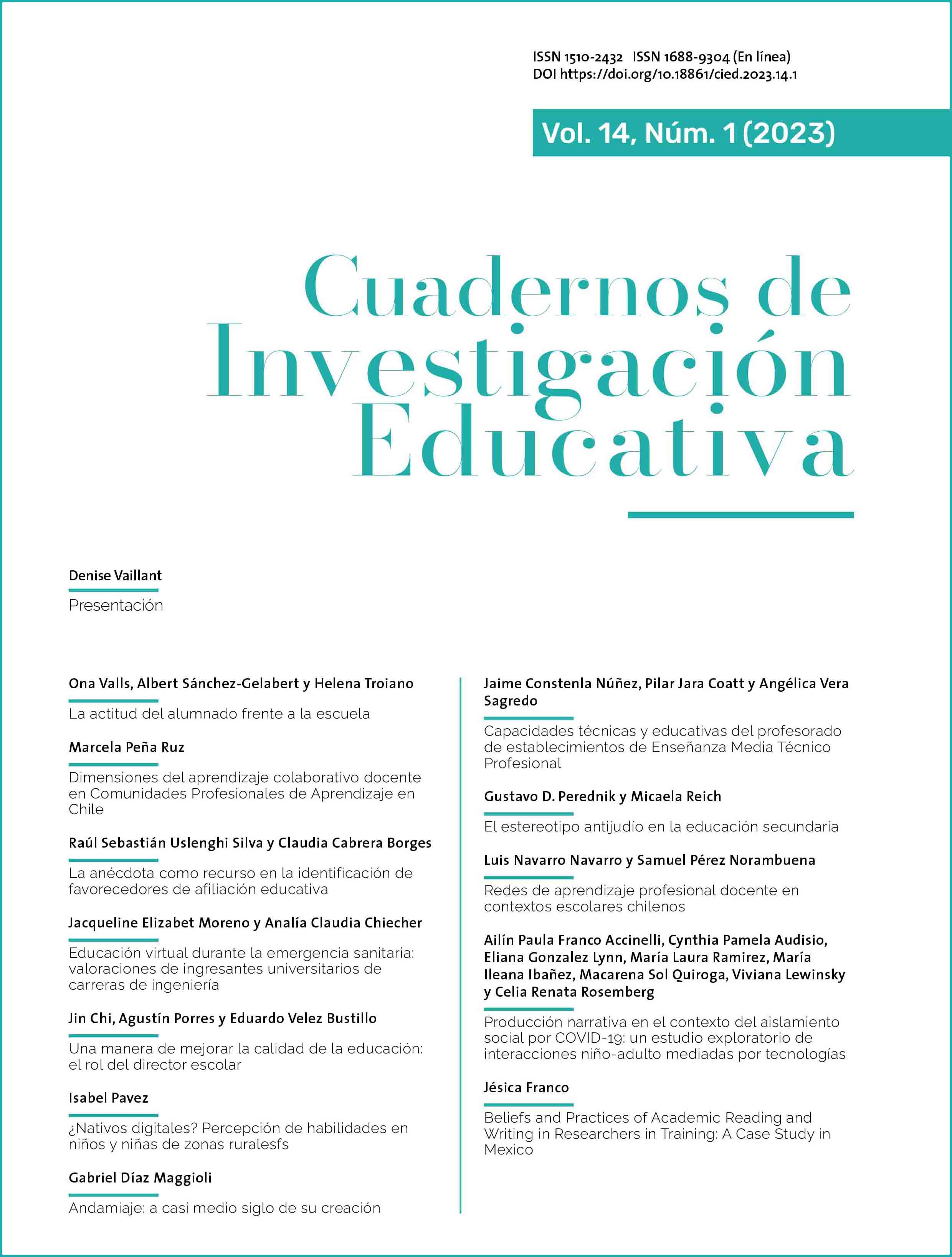El estereotipo antijudío en la educación secundaria
DOI:
https://doi.org/10.18861/cied.2023.14.1.3294Palabras clave:
prejuicios, adolescencia, judíos, antisemitismo, judeofobia, valores, moral, bachillerato, educación secundariaResumen
Los estereotipos de grupo son representaciones sociales en forma de ideas o creencias, y en ellos pueden sustentarse los odios de grupo. Uno de estos odios es el antisemitismo o judeofobia que, aunque su presencia es verificable, es escasamente abordado. La razón de esta escasez puede relacionarse con la complejidad del fenómeno. En general, en todos los estereotipos ocurre que, en la medida en que sean cognitivos, constituyen un campo fértil para la educación. A fin de detectar los estereotipos de grupo, la adolescencia es una edad apropiada, porque el juicio moral ya está formado, y tratarlos podría contribuir a la educación en valores durante esta etapa evolutiva. Se administró un cuestionario de autoinforme a 321 estudiantes de entre 16 y 18 años, en cuatro ciudades de tres países sudamericanos. Asimismo, se realizaron entrevistas a especialistas. Los estudiantes consultados no habían tenido contacto directo con judíos al momento del estudio. El objetivo de la gestión del cuestionario, basada en las premisas del Test de Asociación Implícita, fue obtener palabras asociadas a la voz “judío”. Los resultados indican que casi la mitad de los términos asociados tenían una connotación negativa, vinculada con la noción del dominio. La inclusión en el currículo escolar de algunas explicaciones de este fenómeno podrá ayudar a atenuarlo.
Descargas
Citas
ADL (Anti–Defamation League) (2014). ADL Global 100 – An Index of Anti-Semitism. http://global100.adl.org/
Alaminos Chica, A., & Castejón Costa, J. L. (2006). Elaboración, análisis e interpretación de encuestas, cuestionarios y escalas de opinión. Editorial Marfil.
Allport, G. W. (1954). La naturaleza del prejuicio. Eudeba.
Banks, J. (Ed.) (2012). Encyclopedia of Diversity in Education. SAGE.
Beattie, G. (2013). Our Racist Heart? An Exploration on unconscious prejudice in everyday life. Routledge.
Beelmann, A., & Heinemann, K. (2014). Preventing prejudice and improving intergroup attitudes: A meta–analysis of child and adolescent training programs. Journal of Applied Developmental Psychology, 35, 10-24. https://doi.org/10.1016/j.appdev.2013.11.002
Bodenhausen, G., & Richeson, J. (2010). Prejudice, Stereotyping, and Discrimination. In R. F. Baumeister & E. J. Finkel (Eds.), Advanced Social Psychology (pp. 341–383). Oxford University Press.
Boyd, D. (2013). Moral Education within Difference: Impediments to Appreciating the Moral Other. Hare & Portelli.
Brown, R. (1995). Prejudice - Its Social Psychology. Backwell.
Cárdenas, M., Music, A., Contreras, P., Yeomans, H., & Calderón, C. (2007). Las nuevas formas de prejuicio y sus instrumentos de medida. Revista de Psicología, 16(1), 69-95. https://doi.org/10.5354/0719-0581.2007.18435
Centro Kantor (2020). Universidad de Tel Aviv: informe anual.
Davies, C. (1990). Ethnic humor around the world: A comparative analysis. Indiana University Press. https://doi.org/10.1086/229737
Dion, K. (2001). The Social Psychology of Perceived Prejudice and Discrimination. Canadian Psychology, 45(1), 1-10.
Fiske, S. (2013). What Does Prejudice Reveal About What It Means to be Human? En J. A. Smith (Ed.), Berkeley Annual Conference sobre La ciencia y el misterio de la experiencia humana.
Fiske, S. (2016). Tabla de Fiske en The Fiske Lab. http://www.fiskelab.org/
Foxman, A. (2010). Jews and Money: The Story of a Stereotype. Palgrave Macmillan.
Freeman, D., Loe, B. S., Chadwick, A., Vaccari, C., Waite, F., Rosebrock, L., Jenner, L., Petit, A., Lewandowsky, S., Vanderslott, S., Innocenti, S., Larkin, M., Giubilini, A., Yu, L. M., McShane, H., Pollard, A. J., & Lambe, S. (2020). COVID–19 vaccine hesitancy in the UK: the Oxford coronavirus explanations, attitudes, and narratives survey (Oceans) II. Psychological medicine, 1-15. https://doi.org/10.1017/S0033291720005188
García Venturini, J. L. (1964). Antisemitismo y cristianismo. Revista Comentario.
Gartner, L. (2001). History of the Jews in Modern Times. UP.
Gendler, T. (2008). Alief and Belief. Journal of Philosophy, 105(10), 634-663. https://doi.org/10.5840/jphil20081051025
Hughes, C. (2017). Understanding Prejudice and Education: The challenge for future generations. Routledge.
Kohlberg, L. (1984). The Psychology of Moral Development. Harper & Row.
Lind, G. (1999). The Optimal Age of Moral Education. Psychology & Morality and Democracy & Education.
Morales Vallejo, P. (2011). Guía para construir cuestionarios y escalas de actitudes. Universidad Pontificia Comillas.
Otzen, T., & Manterola, C. (2017). Técnicas de muestreo sobre una población a estudio. International Journal of Morphology, 35(1), 227-232.
Perednik, G. (2018). Judeofobia. Sudamericana.
Pettigrew, T. F., & Meertens, R. W. (1995). Subtle and blatant prejudice in Western Europe. European Journal of Social Psychology, 25(1), 57-75.
Pilkington, H., & Popov, A. (2008). Cultural Production and Transmission of Ethnic Tolerance and Prejudice: Introduction. En Anthropology of East Europe Review, del Proyecto RIME (Releasing Indigenous Multiculturalism through Education) de la Iniciativa sobre Democracia y Derechos Humanos de la Unión Europea.
Ralph, N., Birks, M., & Chapman, Y. (2015). The Methodological Dynamism of Grounded Theory. International Journal of Qualitative Methods, 14(4). https://doi.org/10.1177/1609406915611576
Rodríguez, A. (1991). Psicología social. Trillas.
Ryan, K. (1986). The New Moral Education. The Phi Delta Kappan, 68(3), 228-233.
Scharager, J., & Armijo, I. (2001). Metodología de la Investigación para las Ciencias Sociales [CD–ROM]: Versión 1.0. Escuela de Psicología, SECICO Pontificia Universidad Católica de Chile.
Strauss, A., & Corbin, J. (2008). Basics of Qualitative Research: Grounded Theory Procedures and Techniques. SAGE.
Tenti Fanfani, E. (2005). La condición docente – Análisis comparado de la Argentina, Brasil, Perú y Uruguay. Siglo Veintiuno Editores.
Trachtenberg, J. (1975). El diablo y los judíos. Paidós.
Unión Europea (2018). Encuesta realizada por la Agencia para los Derechos Fundamentales.






